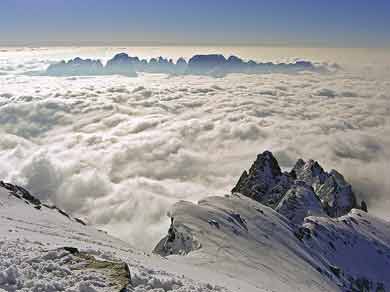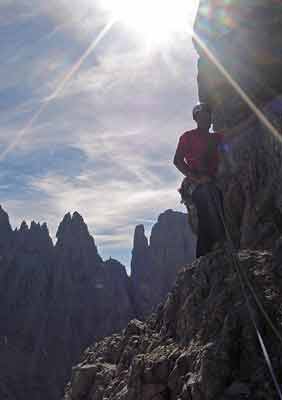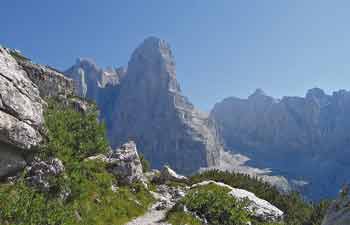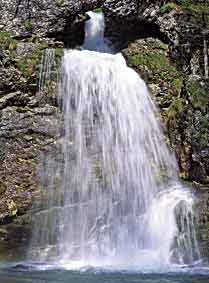| |
 THE FASCINATION OF BRENTA AND THE DOLOMITES THE FASCINATION OF BRENTA AND THE DOLOMITES
Franco De Battaglia
The mountains are the spinal column of an area including the valleys, villages, and communities. It is the strong feature that connects components and compounds their identity. Every place with a distinct culture identifies with mountains, as the mountain is situated where experiences are concentrated and spill out onto its surrounds. What applies to the rain also applies to the cultures. The Alps are the reference point for Tyrol and Walser cultures, as the Pyrenees are for the Basque, the Carpathians for central-Eastern European regions and the Tatras being the focal point for Poland. In order to understand a place, the mountains must be the first port of call. Even Mediterranean Italy with all its contradictions, can’t be fully understood until one first enters the harsh, tormented Apennine territory. The same applies to Trentino whose reference point are the stratified remote coral cliffs of the Dolomites, emerged from the sea and now placed between two rivers that flow to the sea, the Piave in the east and the Adige in the West, both confluent in the Adriatic a short distance from each other. They form the lagoon where Venice rose from, a port facing the Orient, but it is also a “portal” for the sea and far-away places such as Illyria, the Danube and the Balkans leading toward the mountains. The Dolomites are a human and geological "unicum” (in no other mountains does the work of humans tie in so closely with the rocks and nature, triggering an explosion of legends, stories and situations) but they are also a livelihood. The Gruppo di Brenta (Brenta Range) is part of the Dolomites although quite far away, it is almost like a guardian who keeps watch and protects them. They are in fact the last outpost before the great granite bastion of Adamello and Presanella, surrounded by the Val Rendena trench and a large geological fracture called the Linea delle Giudicarie (the Giudicarie Line).
The Gruppo di Brenta is one of the most beautiful mountain ranges in the world, due to the grandeur of its peaks that are over 3300 metres (Cima Tosa and Cima Brenta are the highest summits), the magnificence of its faces and the boldness of its rocky steeples, the most famous being Campanil Basso. The greatest mountaineers in the world such as Bruno Detassis, Cesare Maestri, Ermanno Salvaterra, Giorgio Graffer, George Livanos, Pierre Mazeaud and Paul Preuss have undertaken its rocky challenge, writing glorious and inimitable pages of mountaineering history. Moreover, Madonna di Campiglio has remained one of the first Alpine stations since the 19th century, where the two British and German mountain “schools” (patronised by the frequent visits by Sissi, the Empress and her husband, Francesco Giuseppe) often met and fell out. SAT, Societá degli Alpinisti Tridentini A Campiglio (Company of Trento mountaineers in Campiglio) was started in 1872 to protect the mountains from foreign colonisation which confirms the idea that the mountain is a question of identity, if not real patriotism. But the attraction of the Gruppo del Brenta doesn’t only lie in its faces, or in the network of paths – mostly equipped and challenging, such as the “legendary” Via delle Bocchette path which crosses it at high altitude, making use of the ledge passages – but mostly in the harmonious variety of landscapes and high-mountain chains connected to the valleys that support them. Brenta is actually the only Dolomite group that despite climate change – is still host to expanses of snow, hanging glaciers, ice tongues and snow cushions overhanging the ledges, all situated beside the warmth of its pink limestone. The move from expanses of snow and majestic rock faces to landscape – makes it similar to the Western Alps – softening it at the same time. There is no other mountain so far South that has this marked rock-snow dichotomy. The other salient feature is the connecting point between the two valleys that support Brenta, the Rendena valley in the West, the Val di Non valley in the East, and the central mountain chain. The two valleys are very different from each other (the Rendena is in a perfect line and the Val di Non valley is a sort of extended plateau), but the most striking thing is the particular individualism of the smaller valleys that go back up right under the rocks from the two bigger valleys. They are almost like the naves of an immense cathedral that bring a sylvan and pastoral softness not often found elsewhere, to the otherwise harsh rockiness of the range. This is the case for the Val Brenta valley, which rises from Sant'Antonio di Mavignola in a series of large steps and jumps toward the Bocca di Brenta (Brenta Mouth) which is the pivot and heart of the range. This is a journey that doesn’t only lead toward the support refuges, but is an adventure in itself, and at the same time, is the best introduction to Brenta, being able to appreciate it step by step. But equally important is the approach from the Val d'Algone that rises from Stenico and arrives in the Malga Movlina hut (the site of an old rustic duel for pasture ownership in 1066) which accesses the South sector of the range and  reunites with the Val Brenta valley through the Valagola, featuring a charming lake. Further on, the harsh Val d'Algone valley leads to a refuge of the same name, while the Val delle Seghe valley rises from Lake Molveno to the Massodi and the Bocca di Brenta (Pedrotti refuge), passing under the imposing Croz dell'Altissimo, where the Sesto Grado (Sixth Grade) pioneers undertook the challenge. No less attractive is the Valle di Santa Maira Flavona (Saint Maira Flavona) valley, which comes up from Tuenno, in the Non valley, and from the Lake Tovel, which displayed an exceptional phenomenon of blood red water until 1964 due to a particular alga. This is the kingdom of the bear, which has always inhabited Brenta (it has never been extinct) but ten types have been reintroduced over the past ten years. The Val Flavona valley ends at the Grosté pass and joins up with the path rising from Campiglio and from the Campo Carlomagno pass. Shepherds and haymakers met here on for haymaking from the Non, Sole and Rendena valleys. People toiled in Carlomagno but it was also a meeting place for valley families and different areas. Friendships were strengthened, songs were sung around fires in the evenings, people fell in love and marriages were arranged. In older times the Ginevria pass as it was known, had seen less peaceful passages, when Charlemagne’s knights, four thousand lances according to reports, bivouacked in the ample clearing before going down along the Rendena toward Lake Garda and the Padana plains only to be attacked by Longobards of Desiderio to the rear. reunites with the Val Brenta valley through the Valagola, featuring a charming lake. Further on, the harsh Val d'Algone valley leads to a refuge of the same name, while the Val delle Seghe valley rises from Lake Molveno to the Massodi and the Bocca di Brenta (Pedrotti refuge), passing under the imposing Croz dell'Altissimo, where the Sesto Grado (Sixth Grade) pioneers undertook the challenge. No less attractive is the Valle di Santa Maira Flavona (Saint Maira Flavona) valley, which comes up from Tuenno, in the Non valley, and from the Lake Tovel, which displayed an exceptional phenomenon of blood red water until 1964 due to a particular alga. This is the kingdom of the bear, which has always inhabited Brenta (it has never been extinct) but ten types have been reintroduced over the past ten years. The Val Flavona valley ends at the Grosté pass and joins up with the path rising from Campiglio and from the Campo Carlomagno pass. Shepherds and haymakers met here on for haymaking from the Non, Sole and Rendena valleys. People toiled in Carlomagno but it was also a meeting place for valley families and different areas. Friendships were strengthened, songs were sung around fires in the evenings, people fell in love and marriages were arranged. In older times the Ginevria pass as it was known, had seen less peaceful passages, when Charlemagne’s knights, four thousand lances according to reports, bivouacked in the ample clearing before going down along the Rendena toward Lake Garda and the Padana plains only to be attacked by Longobards of Desiderio to the rear.
Every step across the Gruppo di Brenta range evokes pages of history mixed with elements of nature and this mix that distinguishes it from the others and conveys its attractiveness. It is a mountain for everyone even if mountaineering exploits are only for the skilled. But travelling across it isn’t hard if you bear in mind that it is not a “play place” suitable for all seasons, but on a "spine” – the old name was Spinale – that separates not only the two valleys, but two worlds, that of nature and the artificial. Brenta is a real world of nature and violent atmospheric change. You need to be prudent, prepared and approach a little at a time. This is part of its beauty. But there are many welcoming rest places, stages, and "refuges"... It’s not difficult to plan a trip from one refuge to another, ask information, be advised and learn. The attraction of a holiday in Brenta also means learning about the mountain for whoever experiences it, facing it one step at a time, from the easiest steps to the most difficult. There is no lack of satisfaction, as this mountain allows you to understand the valleys of man and modified nature, the work that has transformed the landscape and the atmospheric storms that batter it. This mountain and its terrain open up another dimension to the walker. Happy walking!
|
|